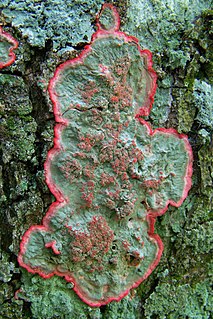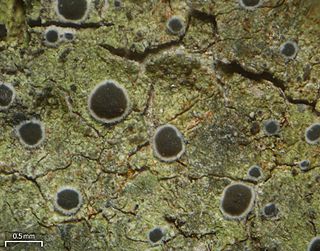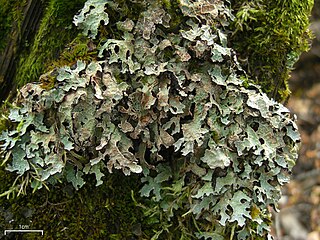
The Arthoniales is the second largest order of mainly crustose lichens, but fruticose lichens are present as well. The order contains around 1500 species, while the largest order with lichenized fungi, the Lecanorales, contains more than 14000 species.

The Pilocarpaceae are a family of crustose lichens in the order Lecanorales. The species of this family have a cosmopolitan distribution and have been found in a variety of climatic regions. Pilocarpaceae was circumscribed by Alexander Zahlbruckner in Adolf Engler's influential 1905 work Die Natürlichen Pflanzenfamilien.

Ramalina fraxinea, the cartilage lichen, is a fruticose lichen with erect or pendulous thalli and branches that are flattened. Colour varies from pale green though yellow-grey to white-grey; apothecia are frequent and soralia may also be present.
Septotrapelia is a genus of lichen-forming fungi in the family Pilocarpaceae. It has four species. It was validly published as a genus in 2007 by lichenologists André Aptroot and Jose-Luis Chaves.

Cryptothecia is a genus of white to greenish crustose lichens that grow on bark, wood, or leaves. in tropical or subtropical areas worldwide. It has a conspicuous prothallus that develops around its periphery which can be bright red in some species, hence the common name wreath lichen. The main vegetative body (thallus) lacks a cortex (ecorticate and is often immersed in the substrate or byssoid. The medulla is white, well defined, and often peppered with calcium oxalate crystals. Ascomata are not well defined, being cushions of soft white mycelium immersed in the medullary tissue, hence the name from the Greek krypto = "to conceal" and theke = "a container or sheath". There are about 45 described species in the genus according to one source, and 75 species according to another. The genus is in the family Arthoniaceae. It contains Trentepohlia, a green alga, as its photobiont partner.

Enterographa is a genus of lichens in the family Roccellaceae.

Lecanographa is a genus of about 40 species of lichens in the family Lecanographaceae. It was circumscribed in 1994 by José M. Egea and Pilar Torrente, with Lecanographa lyncea as the type species.

Pyxine sorediata, commonly known as mustard lichen, is a widely distributed species of foliose lichen in the family Caliciaceae. It has a subtropical to warm temperate distribution, and grows on bark, rocks, and moss as substrates. Pyxine sorediata has been reported from regions of North America, Europe, Africa, Asia, and Australasia.

Punctelia bolliana, the eastern speckled shield lichen, is a species of foliose lichen in the family Parmeliaceae. It is found in North America, with a distribution extending from the Canadian province of Ontario south to the central and northeastern United States and Mexico. It grows on the bark of both deciduous trees and coniferous trees. The combination of characteristics that distinguishes this species from others in genus Punctelia are the absence of the vegetative propagules isidia and soralia, a pale brown lower thallus surface, and the presence of the secondary chemical protolichesterinic acid in the medulla.
Cetrelia sayanensis is a species of foliose lichen in the family Parmeliaceae. Found in Europe, it was formally described as a new species in 2009 by lichenologists Tatyana Otnyukova, Nikolay Stepanov, and John Alan Elix. The type was collected along the Kulumys ridge on the West Sayan Mountains of southern Siberia. Here it was found growing on the bark of an old stem of Sorbus sibirica, at an altitude of 800 m (2,600 ft). It has also been collected in several neighbouring areas, all at altitudes between 400–930 m (1,310–3,050 ft), with the bark of Abies, Betula, Salix, and Sorbus as the typical substrates. In 2019, the lichen was recorded from Austria, its first reported occurrence in middle Europe.
Fuscidea muskeg is a species of crustose lichen in the family Fuscideaceae. Found in Alaska, it was described as a new species in 2020 by Tor Tønsberg and Martina Zahradníková. The type species was collected in the Hoonah-Angoon Census Area of Glacier Bay National Park. Here it was found growing on a branch of the tree Pinus contorta in muskeg. The specific epithet muskeg is an Algonquin word for a blanket bog.

Parmelia barrenoae is a species of foliose lichen in the large family Parmeliaceae. It was formally described as a new species in 2005. Before this, it was lumped together as one of several lichens in the Parmelia sulcata group—a species complex of genetically distinct lookalikes. Parmelia barrenoae is widely distributed, occurring in Europe, western North America, Africa, and Asia.
Lepra lichexanthonorstictica is a species of crustose and corticolous (bark-dwelling) lichen in the family Pertusariaceae. Found in Brazil, it was formally described as a new species in 2021 by Dutch lichenologist André Aptroot. The type specimen was collected by Aptroot from the summit area of Quiriri (Garuva), at an altitude of 1,350 m (4,430 ft); here it was found growing on the bark of a pine tree. The lichen is named after its two major secondary compounds, lichexanthone and norstictic acid. Lepra lichexanthonorstictica has a thin, smooth and glossy thallus ranging in colour from white to very pale yellowish. The thallus has discrete, rounded soralia measuring about 0.5–0.9 mm in diameter.
Cryptothecia lichexanthonica is a species of corticolous (bark-dwelling) lichen in the family Arthoniaceae. Found in Brazil, it was formally described as a new species in 2013 by Edvaneide Leandro de Lima, André Aptroot, and Marcela Eugenia da Silva Cáceres. The type specimen was collected by Lima from the Vale do Catimbau National Park, at an altitude of 885 m (2,904 ft); here it was found growing on smooth tree bark. The lichen has a smooth, pale greenish-grey spreading thallus up to 5 cm (2 in) in diameter. The thallus, which is 0.1–0.2 mm thick, is surrounded by a thin brown hypothallus. The ascospores are muriform, ellipsoid in shape, and measure 55–75 by 22–28 μm. The specific epithet lichexanthonica refers to lichexanthone, a secondary chemical that occurs in the thallus. This compound is rare in the genus Cryptothecia, as the only other congener in which it known is to occur is Cryptothecia assimilis.
Cryptothecia methylmicrophyllinica is a species of corticolous (bark-dwelling) lichen in the family Arthoniaceae. Found in Java, it was formally described as a new species in 2007 by André Aptroot and Jos Leo Spier. The type specimen was collected by Pieter Groenhart in 1954 from West Bantam. The lichen makes a thin, dull, greyish-white thallus. It contains the secondary compound 5-O-microphyllinic acid, which is detectable using thin-layer chromatography; the specific epithet refers to the presence of this substance.
Cryptothecia evergladensis is a species of corticolous (bark-dwelling) and crustose lichen in the family Arthoniaceae. Found in Florida, USA, it was formally described by lichenologist Frederick Seavey in 2009. The type specimen was collected by Seavey in Everglades National Park in a cypress strand. The specific epithet refers to the type locality. The lichen is most often encountered on the bark on Taxodium, but has also been recorded growing on Metopium toxiferum, Sideroxylon salicifolia, Ateramnus lucida, and Lysiloma latisiliquum, and well as on the wood of Conocarpus erectus. Cryptothecia evergladensis contains some secondary compounds, including psoromic acid, 2-O-methylperlatolic acid, and lichexanthone. The last compound, when present in the lichen at sufficient amounts, causes the lichen thallus to fluoresce yellow when shone with a long-wavelength UV light.
Cryptothecia austrocoreana is a species of crustose and corticolous (bark-dwelling) lichen in the family Arthoniaceae. Found in South Korea, it was formally described as a new species in 2017 by Jung-Jae Woo, László Lőkös, Edit Farkas, and Jae-Seoun Hur. The type specimen was collected by the first author near Seonamsa at an altitude of 160 m (520 ft); here it was found growing on the bark of Meliosma myriantha. It also grows on the bark of Carpinus tschonoskii. The lichen is only known to occur at the type locality. The specific epithet austrocoreana refers to the southern part of South Korea.
Angiactis is a genus of crustose lichens of uncertain familial placement in the order Arthoniales. It has four species.

Heiomasia is a genus of corticolous (bark-dwelling), crustose lichens in the family Graphidaceae. It has five species.
Loxospora cristinae is a fungal species classified in 2018, found in a few European countries. It belongs to the division Ascomycota and the family Sarrameanaceae. It was first identified and described in the 19th century, but the species would not be correctly classified until almost two centuries later. Loxospora cristinae is a sterile crustose lichen, meaning it reproduces by a type of vegetative spore that has evolved specifically to produce morphological structures.









